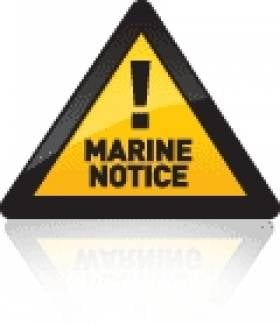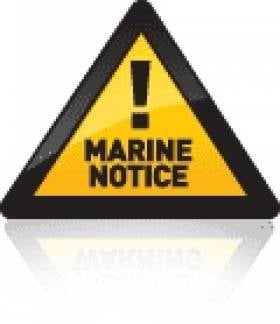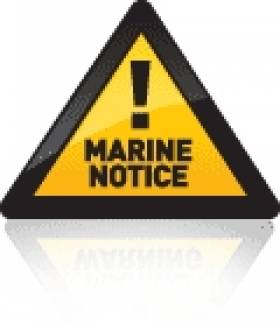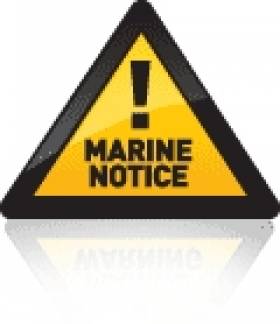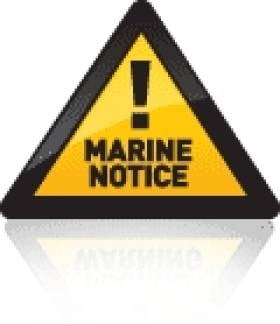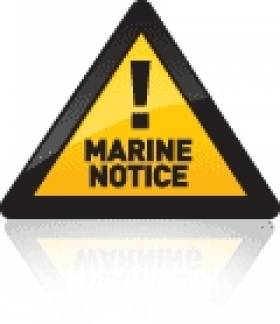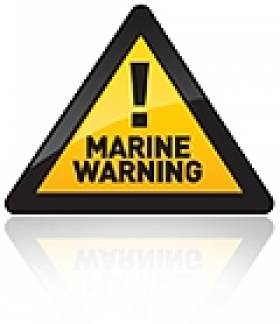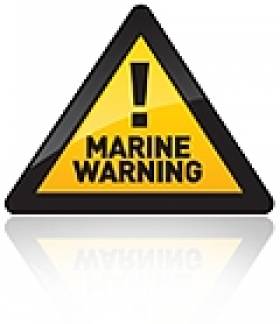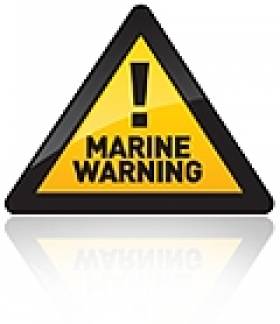Displaying items by tag: Geophysical Survey
Marine Notice: Geophysical Survey In Celtic Sea
#MarineNotice - The latest Marine Notice from the Department of Transport, Tourism and Sport (DTTAS) advises that Osiris Projects were last week scheduled to begin marine survey operations off the south coast in the Celtic Sea.
The marine surveys will extend from the shoreline at two locations in Co Cork across the sea to the shoreline at two locations in northern France.
The survey was set to start on Monday 1 June 2015 to last for approximately three weeks, weather permitting. The survey will be conducted by the MV Proteus (Callsign 2HBL7).
The marine surveys will extend from the shoreline at Ballinwilling Strand (main route) and Ballycroneen Beach (alternative route), across the Celtic Sea, passing the Isles of Scilly, to the French coast west of Roscoff at Moguériec (main route) and Pontusval (alternative route).
The corridor width for each landing will be 250 metres from the high water mark to the 10-metre contour, then the corridor will widen to 500m as the route moves to France.
The survey vessel may be found running both along the corridor, and in the general vicinity of the survey corridor. The survey areas are small boxes which are shown in the detail plan HERE.
Survey operations will involve towing survey equipment on and below the water surface, up to 300m behind the vessel. All vessels, particularly those engaged in fishing, are requested to give the MV Proteus and her towed equipment a wide berth and keep a sharp lookout in the relevant areas.
Full co-ordinates for the relevant work areas are detailed in Marine Notice No 25 of 2015, a PDF of which is available to read or download HERE.
#MarineNotice - The latest Marine Notice from the Department of Transport, Tourism and Sport (DTTAS) advises that a hydrographic and geophysical survey operation will be undertaken by INFOMAR1 off the west coast of Ireland from tomorrow 23 July till 17 August.
The RV Celtic Voyager (Call sign EIQN) – which earlier this year was equipped with a new multibeam sonar – is expected to carry out the survey operations in Killary Harbour and its approaches, off the west coast, in Galway Bay and in an area northwest of Tralee Bay.
The work vessel will be towing a magnetometer sensor with a single cable of up to 100m in length. The vessel will display appropriate lights and markers and will be listening on VHF Channel 16 throughout the course of the survey.
Full details of co-ordinates and maps of the survey areas are included in Marine Notice No 45 of 2014, a PDF of which is available to read or download HERE.
Marine Notice: Geophysical Survey Off Cork Coast
#MarineNotice - The latest Marine Notice from the Department of Transport, Tourism and Sport (DTTAS) advises that TE SubCom, on behalf of Hibernia Express, is scheduled to carry out a geophysical cable route survey extending south from Ballinspittle.
The survey involves multibeam echo-sounder bathymetry, side-scan sonar, magnetometer and sub-bottom profiling off the Irish coast from Ballinspittle, Co Cork, heading south to the 12nm limit and then into Ireland’s EEZ.
The survey will start on 21 July 2014 and will last for approximately four days, weather permitting. Works will be carried out by the vessel RV Ridley Thomas (Callsign V7JK2).
Inshore at Ballinspittle, shallow water survey operations will be carried out by RV Wessex Explorer (Callsign 2WWE).
Both vessels will be towing survey equipment up to 200m astern and will be restricted in their ability to manoeuvre while carrying out the survey. They will also be listening on VHF Channel 16 throughout the project.
All other vessels, particularly those engaged in fishing, are requested to give the RV Ridley Thomas and her towed equipment and the RV Wessex Explorer a wide berth, and keep a sharp lookout in the relevant areas.
Full details of co-ordinates and maps of the survey area are included in Marine Notice No 39 of 2014, a PDF of which is available to read or download HERE.
Marine Notice: Two-Day Geophysical Survey In Killala Bay
#MarineNotice - EGS International Ltd is scheduled today (13 June) to begin a two-day geophysical cable route survey involving multibeam echo-sounder bathymetry, side-scan sonar, magnetometer and sub-bottom profiling off the Irish coast at Killala Bay.
The survey follows from a longer exercise carried out in January this year, and will be focused inshore along a route into Killala Bay detailed by co-ordinates listed in Marine Notice No 34 of 2014, a PDF of which is available to read or download HERE.
The vessel SMS Coastal Cat (call sign EIJD6) is scheduled to carry out the work on a 12-hour operation basis and will display appropriate shapes during daylight operations and lights during night time operations and periods of reduced visibility.
This vessel will be towing survey equipment up to 200m astern and will be restricted in its ability to manoeuvre while carrying out the survey.
As such, all vessels in the area, particularly those engaged in fishing, are requested to give the SMS Coastal Cat and its towed equipment a wide berth and keep a sharp lookout in the relevant areas.
#MarineNotice - The latest Marine Notice from the Department of Transport, Tourism and Sport (DTTAS) advises that a geophysical cable route survey will begin off the Irish coast at Killala Bay on Wednesday 21 May.
TE SubCom is scheduled to carry out the survey, which involving multibeam echo-sounder bathymetry, side-scan sonar, magnetometer and sub-bottom profiling at Killala Bay heading north to the 12nm limit.
The survey will last for approximately 1 week, weather permitting, and will be carried out by the vessel RV Ridley Thomas (Call sign V7JK2).
The vessel will be towing survey equipment up to 200m astern and will be restricted in its ability to manoeuvre whilst carrying out the survey. The RV Ridley Thomas and any assisting project vessels will be listening on VHF Channel 16 throughout the project.
All vessels, particularly those engaged in fishing, are requested to give the RV Ridley Thomas and its towed equipment a wide berth and keep a sharp lookout in the relevant areas.
Co-ordinates for the survey areas and further details are included in Marine Notice No 30 of 2014, a PDF of which is available to read or download HERE.
Marine Notice: Geophysical Survey of Killala Bay
#MarineNotice - EGS International Ltd is scheduled to carry out a geophysical cable route survey involving multibeam echo-sounder bathymetry, side-scan sonar, magnetometer and sub-bottom profiling off the Irish coast at Killala Bay heading north to the 12nm limit.
The survey will start on Monday 13 January 2014 and will last for approximately one month, weather permitting.
The route of the survey from the 12-nautical-mile territorial limit into Killala Bay is detailed in Marine Notice No 11 of 2014, a PDF of which is available to read and download HERE.
The vessels SMS Coastal Cat (call sign EIJD6) and EGS Pioneer (call sign 2EGS9) are scheduled to carry out the work on a 12-hour and 24-hour operation basis respectively, and will display appropriate shapes during daylight operations and lights during night time operations and periods of reduced visibility.
The vessels will be towing survey equipment up to 200m astern and will be restricted in their ability to manoeuvre while carrying out the survey, and all vessels are requested to give this operation a wide berth. All project vessels will be listening on VHF Channel 16 throughout the project.
All vessels, particularly those engaged in fishing, are requested to give the SMS Coastal Cat and EGS Pioneer, and their towed equipment, a wide berth and keep a sharp lookout in the relevant areas.
Marine Notice: Geophysical Survey Off East Coast
#MarineNotice - Osiris Projects is carrying out a geophysical survey off the east coast of Ireland for the next two weeks, according to the latest Marine Notice from the Department of Transport, Tourism and Sport.
The survey began yesterday 26 August, and will last around 19 days, weather permitting. The works involve a side-scan sonar, magnetometer, multi-beam echo-sounder bathymetry and sub-bottom profiling throughout the entire survey area.
The vessel MV Chartwell (Call sign MHGV6) is scheduled to carry out the work during 24-hour operations and will display appropriate day shapes and lights during reduced visibility and night operations.
MV Chartwell will be listening on VHF Channel 16 throughout the project and will also be transmitting on AIS.
The work vessel will be towing survey equipment up to 200m and will be restricted in her ability to manoeuvre. All vessels, particularly those engaged in fishing, are requested to give the MV Chartwell and her towed equipment a wide berth and keep a sharp lookout in the relevant areas.
Full details of co-ordinates of the relevant survey area are included in Marine Notice No 43 of 2013, a PDF of which is available to read or download HERE.
#MarineNotice - The Department of Transport, Tourism and Sport (DTTAS) has issued a Marine Notice advising that a hydrographic and geophysical survey operation is taking place off the south coast till 4 June.
The RV Celtic Voyager (Call sign EIQN) - which performed a similar task off the Clare coast last month - is carrying out the survey operations in an area along the Cork coast marked out in Marine Notice No 18 of 2013, a PDF of which is available to read or download HERE.
The vessel will be towing a magnetometer sensor with a single cable of up to 100m in length. As usual, the vessel will display appropriate lights and markers, and will be listening on VHP Channel 16 throughout the project.
#MarineNotice - Marine Notice No 15 of 2013 from the Department of Transport, Tourism and Sport (DTTAS) advises mariners that a hydrographic and geophysical survey operation is being undertaken by INFOMAR for the Sustainable Energy Authority of Ireland till 25 April.
The RV Celtic Voyager (Call sign EIQN) is carrying out the survey operations within an area bounded by co-ordinates included in the notice, available as a PDF to read or download HERE.
The vessel is towing a magnetometer sensor with a single cable of up to 100m in length. It is also displaying appropriate lights and markers, and will listen in on VHF Channel 16 throughout the project.
Meanwhile, Marine Notice No 16 of 2013 advises that Shell E&P Ireland is deploying a Waverider buoy off northwest Co Mayo to help predict sea conditions for the laying of an offshore umbilical to the Corrib Gas Field later this year.
The buoy is yellow in colour and will flash yellow five times every 20 seconds. The notice includes an image of what the buoy looks like in the water, as well as the co-ordinates of its placement.
All vessels are requested to give the wave buoy a wide berth.


























